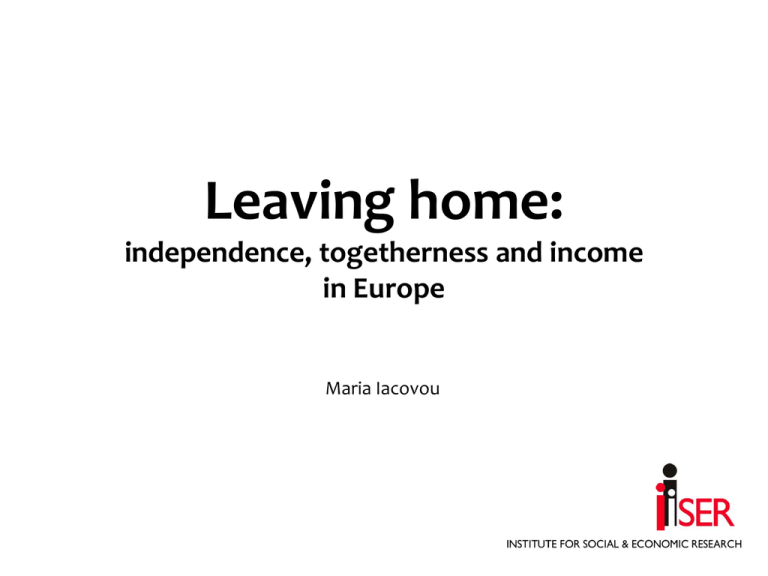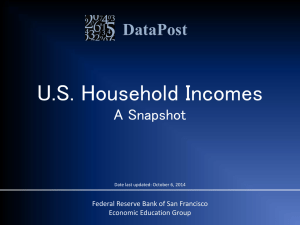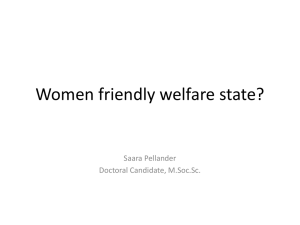Leaving home
advertisement

Leaving home: independence, togetherness and income in Europe Maria Iacovou The transition to adulthood Series of transitions: Finishing school Getting a job Leaving home Partnering Having children Sequencing, and transitions themselves, not universal. Argument for expanding definition of youth upwards 2 3 Motivation Trend towards later home-leaving in OECD countries Conceptualised as being caused by adverse events Unemployment, insecure employment, low incomes, etc And as having adverse consequences Lack of independence for offspring (and parents) Financial consequences for parents [Neither of these is necessarily true] 4 Data All analysis (some from previous publications, some new) from large-scale cross-national data sets European Community Household Panel (ECHP) 1996 – 2002: EU-15 European Union Statistics on Income and Living Conditions (EU-SILC) 2004 onwards: EU-27 5 “North/Western” cluster: UK, France, Germany, Austria, Belgium, Netherlands, Luxembourg, Ireland 6 “Nordic” cluster: Sweden, Finland, Denmark, Norway “North/Western” cluster: UK, France, Germany, Austria, Belgium, Netherlands, Luxembourg, Ireland 7 “Nordic” cluster: Sweden, Finland, Denmark, Norway “North/Western” cluster: UK, France, Germany, Austria, Belgium, Netherlands, Luxembourg, Ireland “Southern” cluster: Greece, Italy, Spain, Portugal, Cyprus, (Malta) 8 “Nordic” cluster: Sweden, Finland, Denmark, Norway “North/Western” cluster: UK, France, Germany, Austria, Belgium, Netherlands, Luxembourg, Ireland “Eastern” cluster: Estonia, Latvia, Lithuania, Poland, Czech R, Slovakia, Slovenia, Hungary, Romania, Bulgaria “Southern” cluster: Greece, Italy, Spain, Portugal, Cyprus, (Malta) 9 “Nordic” cluster: Sweden, Finland, Denmark, Norway, Netherlands “North/Western” cluster: UK, France, Germany, Austria, Belgium, Luxembourg “Southern” cluster: Greece, Italy, Spain, Portugal, Cyprus, (Malta), Ireland “Eastern” cluster 1: Estonia, Latvia, Lithuania, Czech R, Hungary “Eastern” cluster 2: Poland, Slovakia, Slovenia, Romania, Bulgaria Incomes lower than (eg) Turkey, Mexico, Chile, Malaysia 10 Variations in the age at leaving home 38 36 34 32 Men 30 Women 28 26 24 22 NL FR UK DE 20 18 DK FI EE AT BE HU CY CZ LT LU IE LV RO BG PL ES IT EL SI SK PT SE Source: Adapted from Iacovou and Skew (2010) 11 Leaving home by age: four countries (men) Denmark 100% Left home, living with partner 80% 60% 40% 40% Living with parents Left home, living with partner 80% 60% 20% Germany 100% Left parental home, no partner Living with parents 20% 0% Left parental home, no partner 0% 15 20 25 30 35 40 Italy 100% 15 20 25 Left home, living with partner 40 Left home, living with partner 80% 60% 35 Bulgaria 100% 80% 30 60% 40% Living with parents and partner 40% Living with parents 20% Living with parents 20% 0% 0% 15 20 25 30 35 40 15 20 Source: new analysis of EU-SILC (2007) 25 30 35 40 12 Denmark: men (top) and women (b0ttom) 100% Left home, living with partner 80% 60% 40% Living with parents 20% Left parental home, no partner 0% 15 20 25 30 35 40 15 20 25 30 35 40 100% 80% 60% 40% 20% 0% 13 Germany: men (top) and women (b0ttom) 100% Left home, living with partner 80% 60% 40% Living with parents 20% Left parental home, no partner 0% 15 20 25 30 35 40 15 20 25 30 35 40 100% 80% 60% 40% 20% 0% 14 Italy: men (top) and women (b0ttom) 100% Left home, living with partner 80% 60% 40% Living with parents 20% 0% 15 20 25 30 35 40 15 20 25 30 35 40 100% 80% 60% 40% 20% 0% 15 Bulgaria: men (top) and women (b0ttom) 100% Left home, living with partner 80% 60% Living with parents and partner 40% Living with parents 20% 0% 15 20 25 30 35 40 15 20 25 30 35 40 100% 80% 60% 40% 20% 0% 16 Why does home-leaving vary so much? Economic factors – income sufficiency, job security Institutional factors – eg, welfare state Housing markets – supply, price, mortgage markets Social norms Family ties 17 “Independence” and “togetherness” Independence = ability to make your own decisions, support yourself financially, spend time alone… Togetherness = sense of kinship / belonging Assume everyone values both to some extent Not mutually exclusive, but trade-offs for young adults Reher (1998): “Northern” European model characterised by weak family ties; “Southern” model of “strong” family ties 18 “Independence” and “togetherness” CAN’T assume that societies where young adults live with their parents are those with “strong” family ties or a preference for “togetherness” Look at the relationship between income and home-leaving Higher incomes POSITIVELY related to earlier home-leaving Infer preference for independence Higher incomes NEGATIVELY related to home-leaving Infer preference for togetherness 19 Analytical framework Distinguish between parents and children’s incomes Logit regressions separately for each group of countries Sample of young adults aged 18-35 still living at home, analyse the determinants of moving out the following year Also control for: Young person’s age (and age squared) Economic activity (employed/unemployed/home and family/education) Characteristics of family of origin (two-parent/stepfamily/lone parent) Rooms per person (crowding) Parents’ education & age at marriage Maternal employment 20 Results Own income positively related to leaving home. Infer preference among young adults for independence – strongest in Nordic countries Nordic Men Northern Women Men Southern Women Men Own income 0.011*** 0.012*** 0.004** 0.006*** 0.005*** Parental income 0.004* 0.005* 0.005*** 0.004*** -0.005*** Women 0.006*** -0.001 Source: adapted from Iacovou (2011) Parental income ALSO positively related to leaving home in Nordic & Northern countries. But parental income is negatively related to leaving home in Southern countries. 21 Distinguishing between destinations Nordic Men Leave as a single Own income Parental income Leave for partnership Own income Parental income Leave for education Own income Parental income Northern Women Men Southern Women Men Women 0.018*** 0.005 0.019*** 0.005 -0.001 0.005* 0.004 0.012*** 0.004* 0.001 0.006* 0.004 0.014** 0.002 0.012** 0.005 0.008*** 0.005** 0.008** -0.001 0.005*** -0.006*** 0.005*** -0.003* -0.001 0.010* 0.004 0.010** 0.002 0.007* 0.005 0.012*** -0.007 -0.002 0.009** 0.008** Source: adapted from Iacovou (2011) Negative effect of parental income now apparent for both sexes in Southern countries 22 Does the effect of income vary with age? Answer: yes! The effect of own income does not vary significantly with age The effect of parental income does vary Theory: parents use their incomes to delay home-leaving when offspring are “too young”, and use their incomes to encourage home-leaving when offspring are “old enough” (or “too old”). How old is “old enough”? About age 20 in Nordic countries About age 22 in Northern countries About age 27 for women in Southern countries About age 35 for men in Southern countries 23 And Eastern Europe? Own income…. 0.25 0.20 ** ** Men Women 0.15 ** 0.10 0.05 ** ** ** * ** 0.00 Nordic North South East (1) East (2) Effect positive everywhere, but much larger in Nordic countries Adapted from Skew and Iacovou (2011) 24 And Eastern Europe? Parental income… 0.08 * Men 0.06 0.04 Women * ** Effect positive in Eastern [2] group (Romania, Bulgaria, Slovakia, Slovenia, Poland) 0.02 0.00 Nordic North South East (1) East (2) -0.02 -0.04 ** Effect negative in Eastern [1] group (Baltic states plus Hungary and Czech Republic) 25 Returns home Finland Denmark Netherlands UK Belgium Luxembourg France Germany Austria Ireland Percentage of parents Portugal Percentage of young people Spain Italy Greece 0 1 2 3 4 5 Percentage experiencing a return home Source: Iacovou and Parisi (2009), using data from the European Community Household Panel 26 Conclusions Wide variations in age at leaving home Many factors involved in variations – within and between countries Norms play a role Preferences for togetherness versus independence play a role Economic constraints evident, particularly across some countries of Eastern Europe 27 Who supports whom? Poverty, financial strain and intergenerational co-residence Maria Iacovou and Maria Davia Young people’s incomes as a % of their household’s incomes (sample: young people aged 19-34 living with their parents) 30 25 20 15 10 5 0 LV UK IE EE ES BG CZ AT HU NL LT PT SI NO DK GR RO IS SK IT SE CY FI PL BE DE LU FR Reasons for variation Household size One parent/two parents/other adults/children Employment Youth employment rates Parents’ employment rates Employment of other adults in household Wages Wages of young adult in relation to parents’ wages Benefits 29 29 UK 25 23 21 IS 19 17 DE FR LV 25 23 21 IS 19 LU DE 17 FR 15 15 20 30 40 50 60 70 % with 2 parents in paid work LV 27 IE UK 25 23 21 IS 19 DE 17 FR 15 0 5 10 15 20 25 % with no parent in paid work 30 35 40 45 % with 1 parent in paid work 29 mean % h/h income from YP IE UK 27 mean % h/h income from YP mean % h/h income from YP LV IE 27 30 35 50 55 29 mean % h/h income from YP LV IE UK 27 25 23 21 19 CY LU DE 17 FR 15 10 20 30 40 % living with one parent only 50 29 IE mean % h/h income from YP 27 LV UK 25 23 21 IS 19 DE 17 FR 15 35 45 55 65 75 85 % of young people who have a job Do the level of earnings, as well as having a job, matter? 29 IE LV UK mean % h/h income from YP 27 25 23 21 19 17 DE FR 15 20 30 40 50 60 70 80 90 mean youth LAH earnings as % of fathers' earnings do we observe this pattern just because of age differences between the young people still living at home? 29 29 IE LV UK 25 23 21 19 DE 17 IE UK 27 mean % h/h income from YP mean % h/h income from YP 27 LV 25 23 21 19 DE 17 FR FR 15 15 20 30 40 50 60 70 80 90 mean youth LAH earnings as % of fathers' earnings 22 23 24 25 26 27 mean age of young person LAH 29 IE mean % h/h income from YP 27 LV UK 25 EE 23 SI Both the age distribution AND age-earnings profiles contribute to differences in earnings 21 19 PL DE 17 FR 15 40 60 80 100 Earnings of 23-28 as % of earnings of 50-55 120 Scandinavian countries: many 2-earner parents; low-ish youth employment rate, low youth earnings 30 25 20 15 10 5 0 LV UK IE EE ES BG CZ AT HU NL LT PT SI NO DK GR RO IS SK IT SE CY Including predicted levels…………. FI PL BE DE LU FR North/Western countries: fairly low % with jobs (except AT and NL!), low youth earnings (again, except AT and NL) 30 25 20 15 10 5 0 LV UK IE EE ES BG CZ AT HU NL LT PT SI NO DK GR RO IS SK IT SE CY Including predicted levels…………. FI PL BE DE LU FR High employment and relative earnings; high % lone parents Low % of 2-worker parents, high % with jobs, fairly high % with only 1 parent. 30 25 20 15 10 5 0 LV UK IE EE ES BG CZ AT HU NL LT PT SI NO DK GR RO IS SK IT SE CY Including predicted levels…………. FI PL BE DE LU FR These figures cover entire income range Are there differences between rich and poor households? Expect young people in wealthier households to “contribute” a lower % of the household’s income < 75% median income 30 75-100% median income 25 > 100% median income 20 15 10 5 0 NO IS DK SE FI < 75% median income 30 75-100% median income > 100% median income 25 20 15 10 5 0 LV EE BG CZ HU LT SK RO SI PL < 75% median income 30 75-100% median income 25 > 100% median income 20 15 10 35 5 30 0 25 ES PT CY GR IT < 75% median income 75-100% median income > 100% median income 20 15 10 5 0 IE NL UK AT DE LU BE FR Omitted material... Multivariate analysis of characteristics associated with high % of incomes YPs’ role in determining poverty status Calculate household income and poverty status Counterfactual: “remove” young person and all the income associated with their presence in the household Calculate counterfactual poverty status of household Allocate hypothetical benefits to young person and calculate their counterfactual poverty status Eight possible sets of outcomes % of households below 75% median 10 Not poor - would be poor if YP left 9 Poor - wouldn't be poor if YP left 8 7 6 5 4 3 2 1 0 SE IS FR LU FI BG CZ NO NL BE RO SK PL HU CY DK EE LT IT PT SI DE UK LV AT IE GR ES The issue of sharing Adult children don’t always share their funds with the rest of their households But we can assess the extent to which children contribute to household coffers, as follows: HS120: describe your ability to make ends meet 6-point scale, from “great difficulty” to “very easily”. Generate a variable indicating year-on-year change Take a sample of households with young adults co-resident with parents in year t Generate variable indicating if young people leave home Multinomial regressions of change in making ends meet Define 3 outcomes: worse – same – better What do we expect? Get worse Stay the same Improve YP with job leaves YP without job leaves + household loses YP’s income which they previously shared OR N/S if YP was not sharing their income + if those remaining in the household have to continue subsidising the YP - - + if the household were already subsidising the YP + if those remaining in the household no longer have to subsidise the YP OR N/S if those remaining in h/h still have to subsidise the YP Marginal effects: all countries pooled (sample of households with YP aged 25-25) YP with job leaves YP without job leaves 5.8% *** -2.4% *** Stay the same - - Improve 0.1% n/s 4.9% *** Get worse By country groups: YP with job leaves Nordic North/West Southern Eastern YP without job leaves Get worse 8.5 * 3.6 Improve 2.9 7.6 * Get worse 3.5 -7.0 *** - 0.7 4.8 * Improve Get worse 7.2 *** 0.5 Improve -0.2 6.1 *** Get worse 4.0 *** Improve 1.0 -4.0 *** 3.8 *** Next steps Already: Looked at age of young person: no systematic differences between 25-29s and 30-35s No difference between men and women, once you control for income Control for contemporaneous changes in Income of other family members Household composition YP getting or losing a job but remaining in household Assess the % of YPs’ income which is “shared” Look (cross-sectionally) at the relationship between YPs’ incomes and parents’ subjective assessments. Conclusions Economic support between young people and their families is not all one way Young people’s incomes do contribute, in some meaningful way, to their families’ sense of financial security The degree of this contribution is strongly related to young people’s incomes and labour market status





